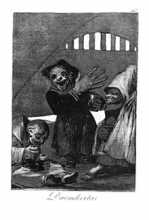Fans of JRR Tolkien are familiar with “Orcs,” the monstrous humanoid thugs of Sauron and Saruman. And fans of a host of lesser fantasies and role-playing games are familiar with them too, often in rather silly permutations. If you've read “The Hobbit” as well as “Lord of the Rings,” you know that Tolkien's Orcs were originally referred to as goblins. But what is a goblin, exactly?
In traditional European folklore, there are a variety of “fairy” races, including the aristocratic “Daoine Sidhe” of Ireland (who are much like Tolkien's elves), kobolds (who work deep in underground mines), seal-people, dwarfs, water-horses, river maidens and so on.
There isn't really any cut-and-dry definition of what a goblin is, but essentially they are small and ugly fairy creatures and are usually mischievous at best or downright malevolent at worst. In Scottish fairy-lore, all sorts of fairy creatures are portrayed as being either “seelie” or “unseelie.” Seelie fairies are perilous but not bad as such, while unseelie fairies are bad all the way through. Goblins would definitely fit into the unseelie category, but their badness is more often petty than downright evil. The goblins in “Labyrinth” are pretty close to the folklore conception, while their king in the movie (played by David Bowie) is more like an elf or a Sidhe. Tolkien's goblins in “The Hobbit” are more like folklore goblins than his Orcs in “Lord of the Rings,” particularly his Uruk-Hai or “soldier Orcs” which are rather more imposing than traditional goblins.
